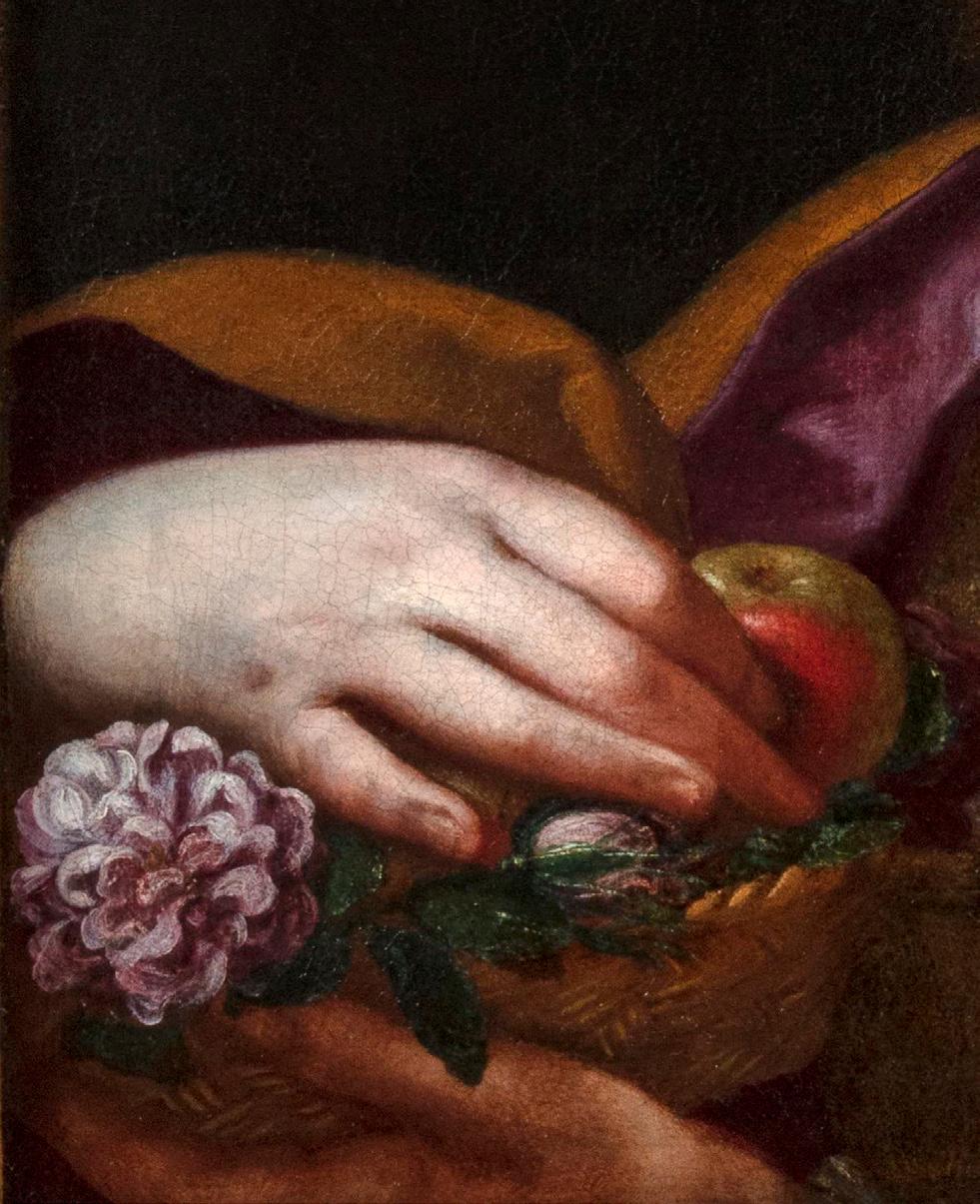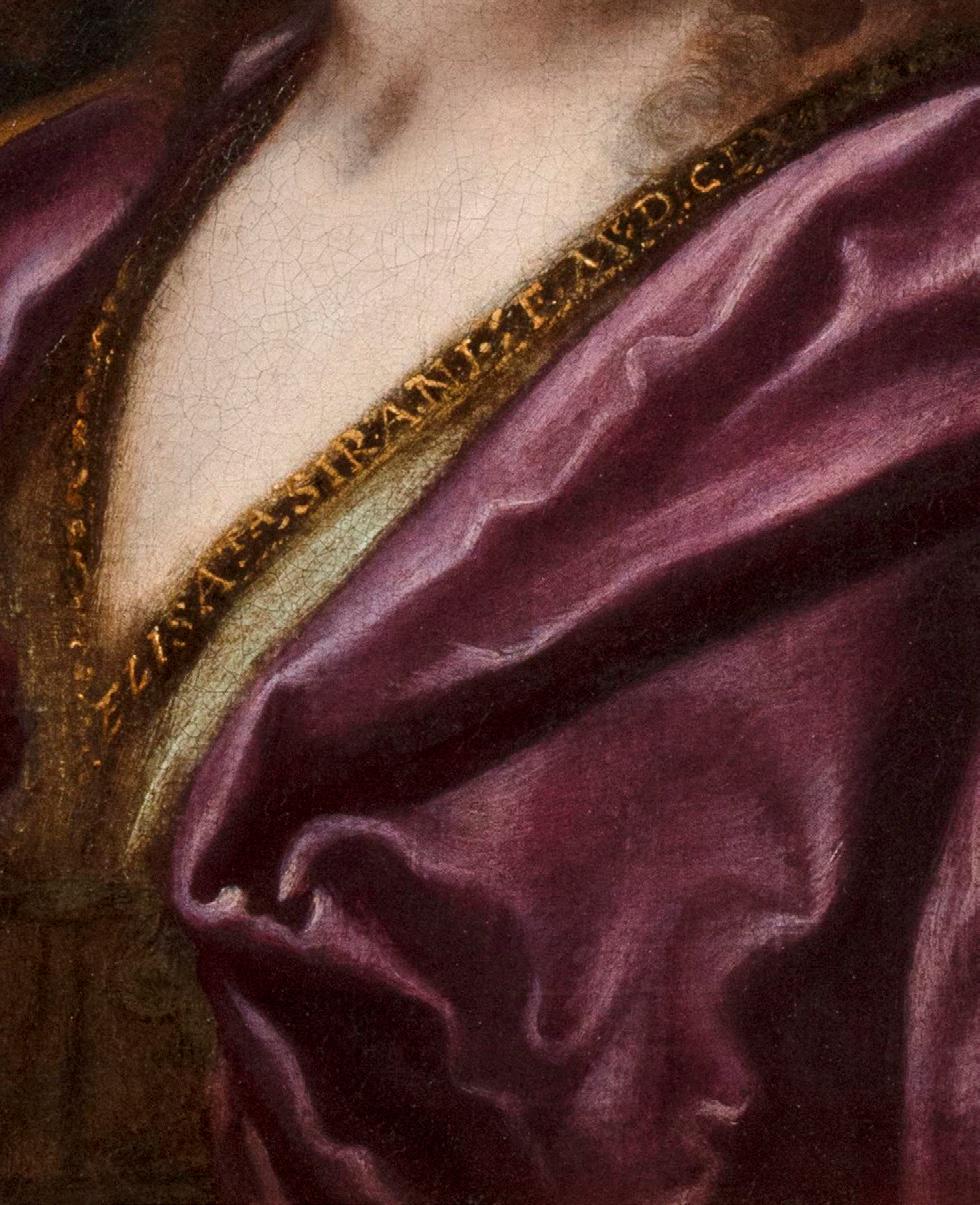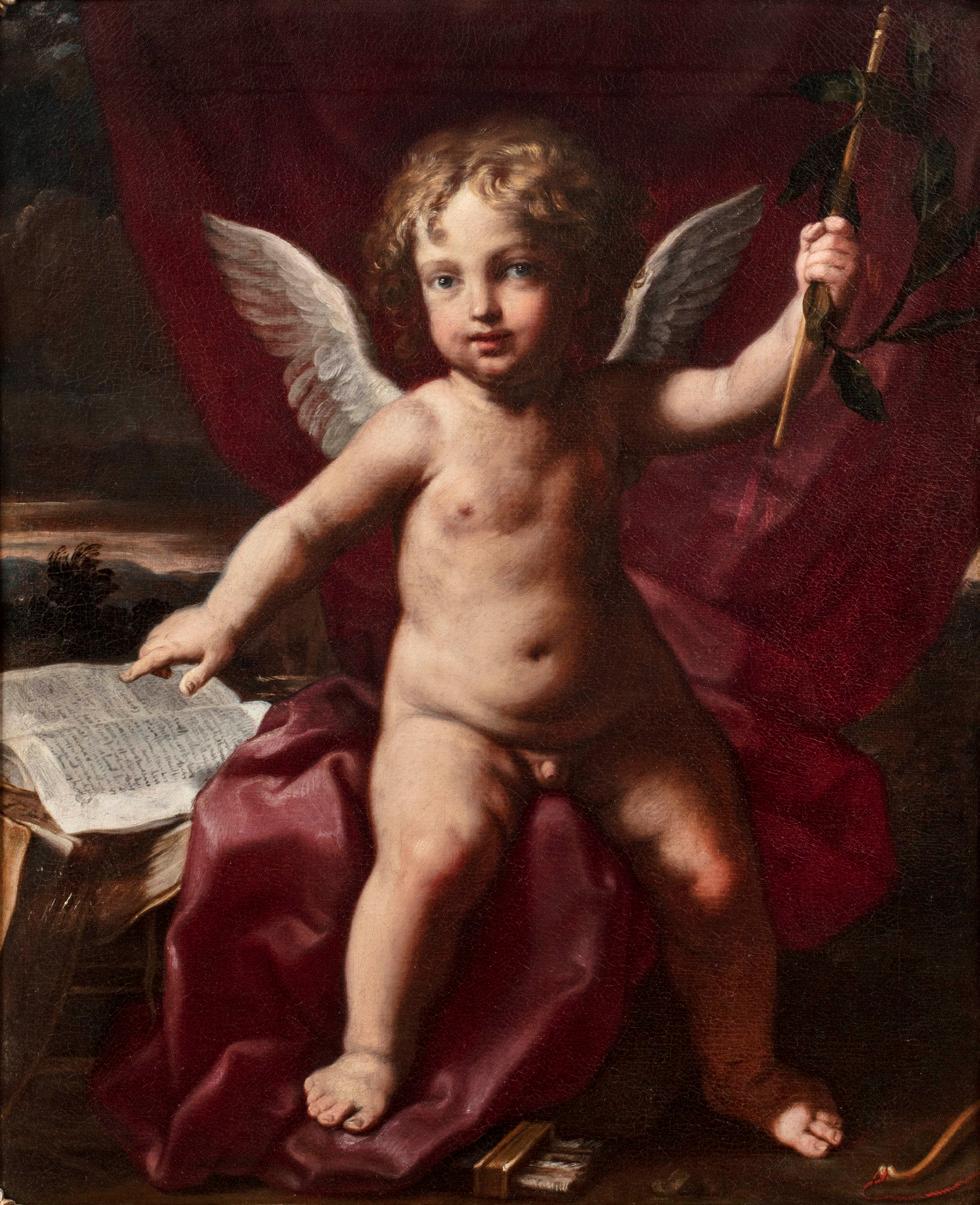

Elisabetta Sirani: Maestra of Baroque Bologna
September 2023
ROBERT SIMON FINE ART
CATALOGUE BY Dominic Ferrante with Robert B. SimonFront and back covers: Elisabetta Sirani, Omnia Vincit Amor and Head of a Youth.
© 2023 Robert Simon Fine Art, Inc. Photography by Glenn Castellano
For availability and pricing, please contact the gallery. High-resolution digital photographs and condition reports are available upon request.
A digital copy of the catalogue is accessible on our website or by scanning the QR code below.
 ROBERT B. SIMON RBS@ROBERTSIMON.COM DOMINIC FERRANTE JR. DFJ@ROBERTSIMON.COM
ROBERT B. SIMON RBS@ROBERTSIMON.COM DOMINIC FERRANTE JR. DFJ@ROBERTSIMON.COM
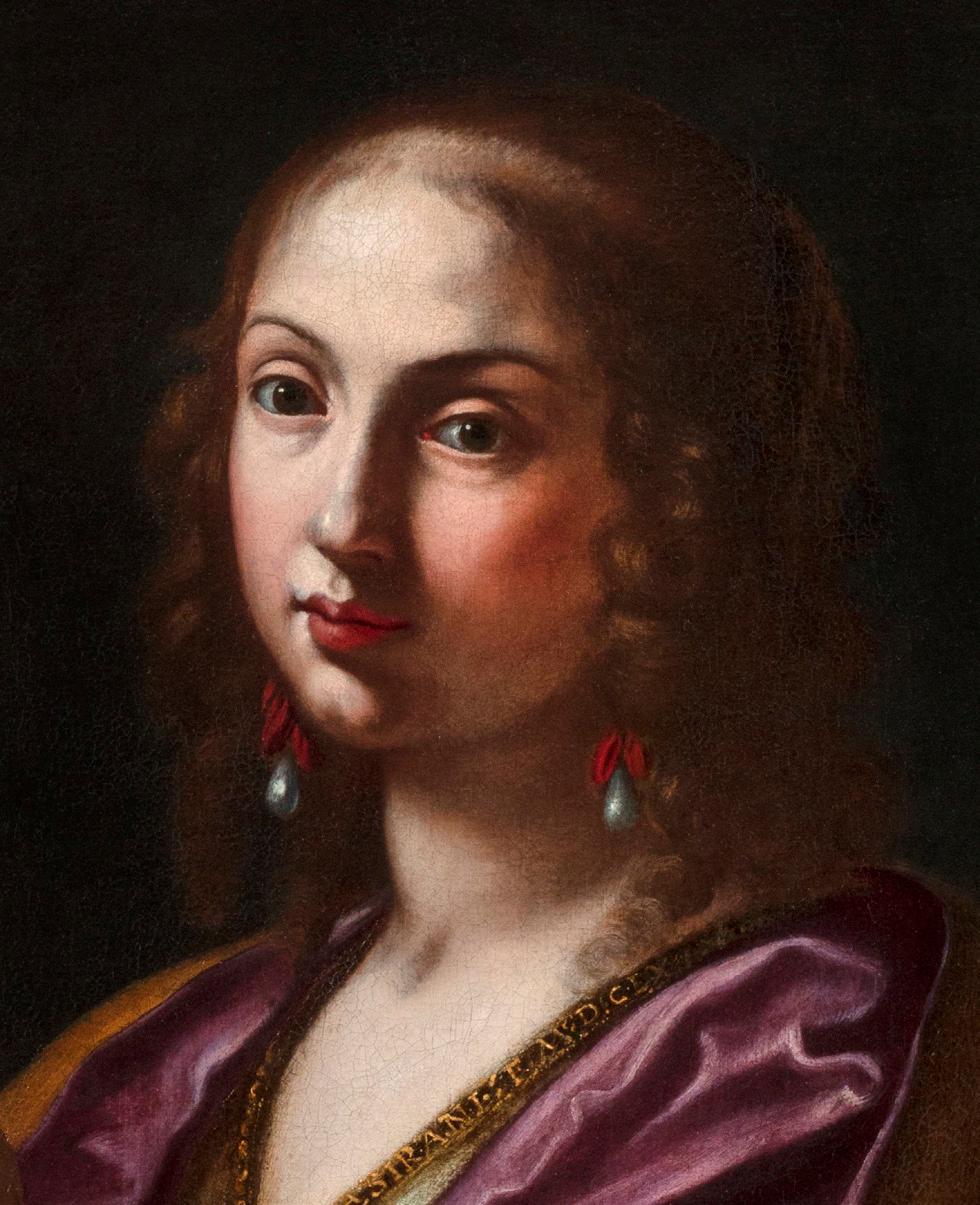
Introduction
WHILE THE CAREERS of so many female artists of the past lie in obscurity, that of Elisabetta Sirani is exceedingly well documented—a consequence of her pride in signing her paintings, her own record of them in a manuscript catalogue, and the contemporary reception and acclaim that she received across the brief ten years of her activity as an artist. Her accomplishments as painter, draughtswoman, printmaker, teacher, and studio capomaestra were recognized during her lifetime and eulogized after her tragic death in 1665 at age 27. Her significance both as an artist and a cultural phenomenon has been the subject of serious and inspired study beginning with the writings of the Bolognese historian Cesare Malvasia in 1678, through generations of Italian scholars, to two contemporary art historians who have championed Sirani in English, Babette Bohn and Adelina Modesti.
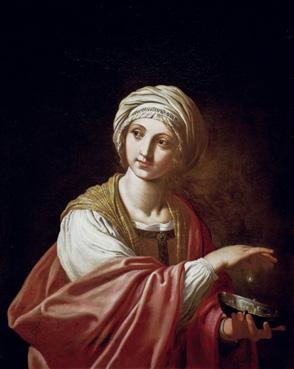
This exhibition is a focused homage to this fascinating artist, occasioned not by any anniversary, but from personal enthusiasm and the kind of serendipity that occasionally befalls an art dealer. Over twenty years ago I was able to identify and
acquire Sirani’s Cleopatra, later purchased by the Flint Institute of Arts (Fig. 1).1 That painting had previously passed as a work by Guido Reni, the master of Elisabetta’s father Giovanni Andrea Sirani, thus her artistic “grandfather.” In 2005 I recognized another putative Reni, a Virgin in Prayer, as a work by Elisabetta, a work which passed to the collection of the late Jane Fortune (Fig. 2).2 More recently, the Delilah and a previously unknown version of the artist’s last work, the Portrait of Anna Maria Ranuzzi as Charity, were acquired from Robert Simon Fine Art by a private collector, who has generously agreed to loan them to the present exhibition.
Fig. 1. Elisabeth Sirani, Cleopatra, Flint Institute of Arts, Flint, MI.The three other paintings exhibited here illustrate the variety of the artist’s oeuvre. The small Madonna and Child is an example of what was the artist’s most beloved subject, one which she repeated with endless variation and charm. Omnia Vincit Amor is both a rich and compelling classical allegory and an ebullient depiction of a mirthful child. The newly discovered Portrait of Ortensia Leoni Cordini as Saint Dorothy is a rare allegorical portrait, incorporating still-life elements into a sensitive depiction of a beautiful woman who directly engages the viewer. Like the Delilah and Anna Maria Ranuzzi, this painting features a signature fictively embroidered into the subject’s dress, a proud hallmark of Sirani’s identity.
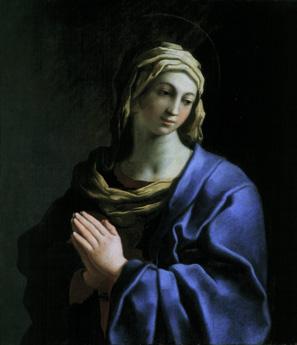
Disparate drawing modes employed by the artist are also represented in the exhibition. Two sheets are in Sirani’s celebrated brush ink wash technique already heralded by Malvasia for its dramatic and expressive facility, while a rare Head of a Youth in colored chalks and pastel was both preparatory and a finished work in its own right. Sirani’s activity as a printmaker is illustrated by a superb example of her most celebrated etching.
Museum exhibitions are typically organized and planned over years. This celebration of Elisabetta Sirani’s career was conceived, prepared, and executed over a six-week period beginning mid-July. My sincere thanks are due to the lenders, scholars, curators, colleagues, conservators, and friends who have embraced what some might term a pop-up show, but which in fact represents the first monographic exhibition devoted to the artist outside of Italy.
Robert B. Simon Fig. 2. Elisabeth Sirani, Virgin in Prayer, Jane Fortune Collection.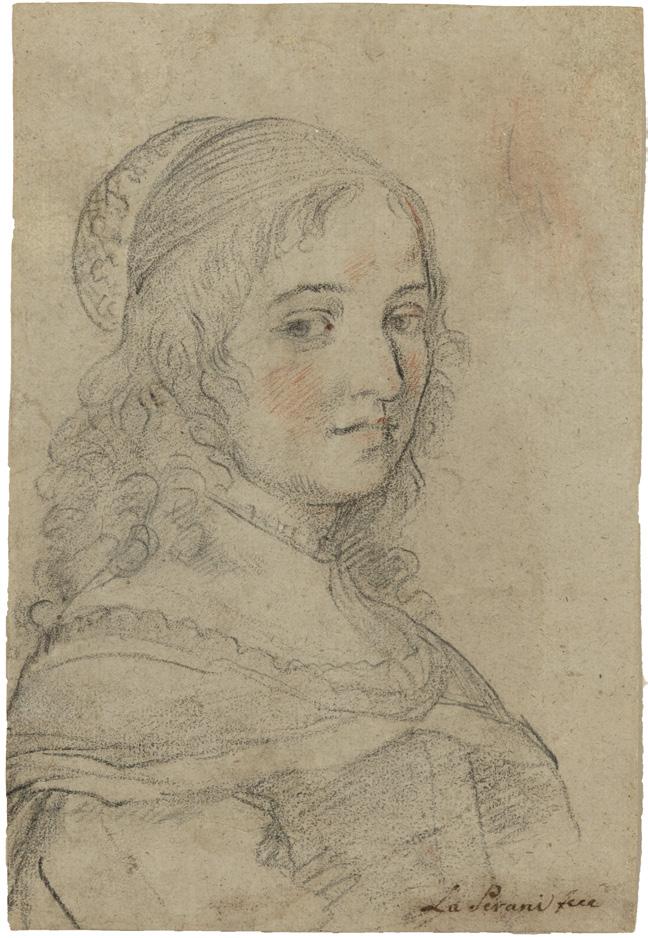
Elisabetta Sirani
(Bologna, 1638 – 1665)
FAMOUSLY DESCRIBED by Carlo Malvasia as “the glory of the female sex, the gem of Italy, the sun of Europe,” Elisabetta Sirani enjoyed great renown across Europe for her prolific talent and reputed beauty. Daughter of Giovanni Andrea Sirani, Guido Reni’s principal assistant, she had begun painting by the age of 17, most likely training under her father, since as a woman she would not have had access to an academy. Sirani worked principally for private aristocratic and ecclesiastic patrons, producing small-scale devotional works, as well as larger religious and historical pictures. She also executed altarpieces for major churches in and around her native city of Bologna.
In his biography of Sirani, Malvasia referred to her with the masculine term for a master in Italian, “maestro.” He seems to have done so to underscore his praise of a woman who was to him the equal of any male artist. In English we are slowly abandoning the few gendered terms that remain: actress, poetess, waitress, even heroine. But while our preference for neutral terminology today is meant to reflect a social equality between the sexes, we cannot forget that in the 17th century, this was hardly the case.
To ignore Elisabetta Sirani’s gender, which we have admittedly done when discussing her paintings and drawings, overlooks what a phenomenon she was even in the comparatively liberal environment of Bologna. While her being a woman was not essential to her creating a beautiful work of art—perhaps what Malvasia meant—it is hugely significant in terms of her biography, social standing, and career as an artist. That is to be celebrated and revered, and for this reason we have emphatically used the term “maestra” in the title of this exhibition.
Portrait of Ortensia Leoni Cordini as Saint Dorothy
Signed and dated 1661 on the neckline: ELISA.TA SIRANI F. MDCLXI
Oil on canvas
23 ¼ x 19 ⅝ inches (59 x 50 cm)
PROVENANCE
Private Collection, Sweden; acquired by the grandfather of the collector in the 1920s, until 2022.
LITERATURE
Carlo Cesare Malvasia, “Nota delle Pitture fatte da me Elisabetta Sirani,” in Felsina Pittrice: Vite de’ Pittori Bolognesi, Bologna, 1678 (ed. Giampietro Zanotti, 1841), vol. 2, p. 396.
ELISABETTA SIRANI’S PORTRAITS ARE AMONG her most rare and prized paintings. Our recently discovered painting, together with a related version in the Chazen Museum of Art (Fig. 1), are the earliest known portraits by the artist, identifiable with a commission recorded in Sirani’s own list of her works, published by Malvasia in his Felsina Pittrice of 1678. The artist there records two paintings made for the Florentine Francesco Cordini in 1661—a Cupid and a “portrait of his wife as Saint Dorothy.”1 Until the discovery of our painting, the portrait at the Chazen Museum had exclusively been associated with this entry. The reemergence of our portrait, with identical signature and date, now indicates that Sirani made two autograph versions of the portrait, much as
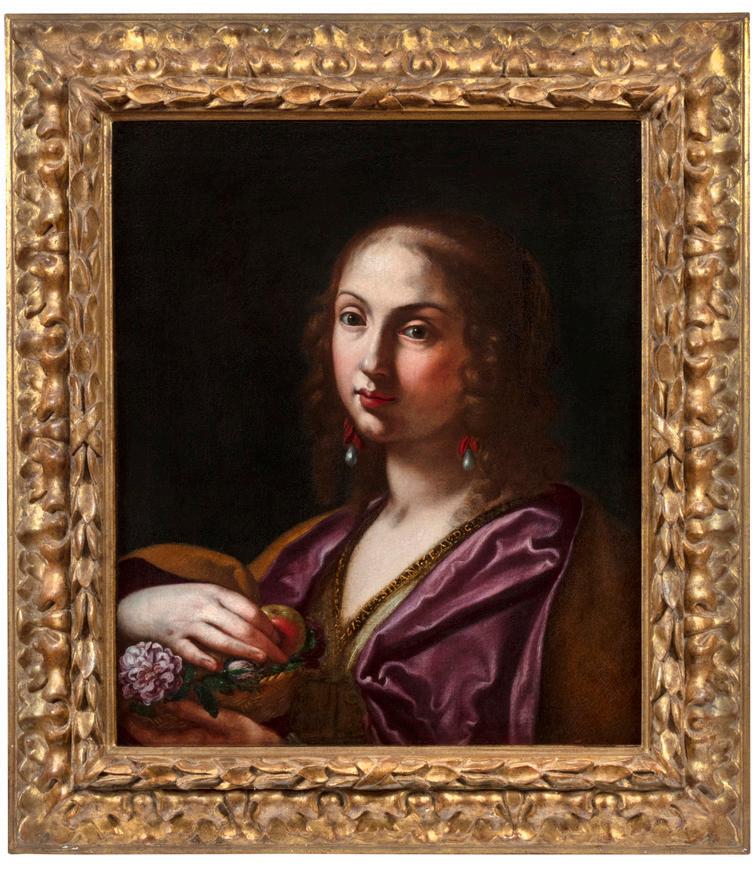
she did in her Portrait of Anna Maria Ranuzzi as Charity of 1665, with versions in a private collection (see catalogue number 5) and the Cassa di Risparmio of Bologna.
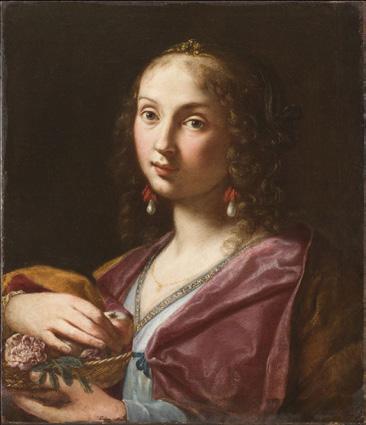
Our portrait depicts the Bolognese noblewoman Ortensia Leoni Cordini in the guise of the early Christian virgin martyr Dorothy (Dorothea). According to her legend, Dorothy had fled from Rome to the city of Caesarea in Cappadocia (today’s Kayseri in eastern Turkey) to avoid persecution. Yet there she was horrifically tortured for her beliefs and her refusal to marry the pagan governor. She miraculously survived these depredations unscathed, while relating a vision of herself holding a basket of apples and roses from the heavenly garden of Christ. Dorothy was ultimately condemned to death by beheading. On her way to her martyrdom, she was accosted by a scribe named Theophilus who mockingly asked her to send him a heavenly basket of apples and roses. After her death, an angel appeared to Theophilus, presenting him with such a basket, causing his immediate acceptance of Christianity. While the choice of saint in the present portrait alludes to the sitter’s virtue, the role of Dorothy as the protector of young couples is significant given Ortensia’s marriage to Francesco Cordini just three years before the portrait was painted.
The depiction of strong or virtuous women from the Bible or Antiquity was popular in 17th-century Bologna, not only in the visual arts but also in literature and theatre.2 Sirani produced numerous paintings of such heroines and, given her own gender and young age, it is evident that these subjects held special appeal
to the artist. Moreover, as Adelina Modesti has argued, Sirani consciously presents these figures as victors rather than victims.3 Both the portraits of Ortensia Leoni Cordini and Anna Maria Ranuzzi employ the device of allegorical portraiture, casting the subject in the role of a female saint or virtue. Significantly, in her own SelfPortrait (Pushkin Museum, Moscow), Sirani portrays herself as an Allegory of Painting.
In addition to appearing in Malvasia’s transcribed list of the artist’s works, Sirani’s portrait of Ortensia Leoni
Cordini is memorialized in two poems by the Bolognese historian Gasparo Bombaci. These poems, recorded in Giovanni Luigi Piccinardi’s La Poesia Muta
Celibrata della Pittrice Loquace (The Silent Poetry Celebrated by the Talkative Painting), demonstrate the fame that the portrait must have had in its day, unusual for such a private commission. One of the poems is dedicated to Elisabetta’s sister Barbara, and is written as if addressing her while Elisabetta is in the act of painting
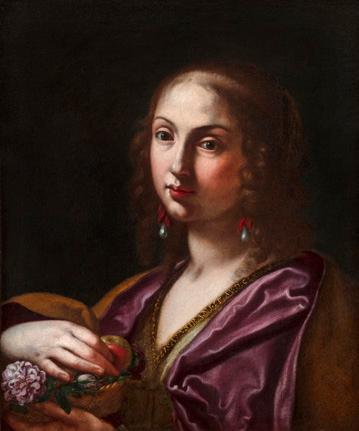
Ortensia Leoni Cordini’s portrait.4 The second poem speaks more directly about the beauty of painting and how Elisabetta amazes all her pupils while painting
Ortensia’s portrait.5
Our painting is prominently signed and dated on the neckline of the sitter’s garments. The visibility of the signature is notable given that a remarkable 70% of Sirani’s extant paintings are signed.6 This is a considerably higher percentage than any other artist of the period, male or female. Malvasia speculated that this practice was prompted by Elisabetta’s desire to distinguish her work from her father’s output and thereby refute rumors that he helped his daughter with
her paintings. While this certainly seems plausible, the frequency and prominence of Sirani’s signatures more broadly reflects the artist’s pride of authorship and her determination to assert herself in what was very much a man’s world.
The two portraits of Ortensia Leoni Cordini present subtle differences— some due to choices by the artist and/or sitter, others the result of the varied conservation histories of the canvases (Figs. 1-2). Between them glazes survived disparately in different passages, and the Chazen portrait had been subject to a perplexing intervention, though one that can now be understood as relatively minor. Technical evidence from recent conservation has indicated that the painting had been altered in the past, having been reduced along the left side, while at the right the tacking strip was opened up to compensate for the reduction in width. The top edge appears to have been cut as well, and an added strip appended to the original canvas along the bottom. The intention, it would seem, was to create a perfectly symmetrical composition, placing the subject in the center, where it would be the focus of the elaborate rococo frame in which the canvas had been mounted (Fig. 3). So as not to lose part of Ortensia’s hand and basket in the process, an irregular piece of canvas measuring 22 x 17.3 cm and containing those elements was cut from the lower left corner of the painting, trimmed, and reintegrated slightly to its right (Fig. 4). Unfortunately, the deep red rose to the right of the apple, visible in our painting (Fig. 5) was eliminated by the procedure. The extent of the shift is evident by comparing the width of the blue blouse to the right of the basket in the Chazen painting with the broader expanse in our work. While relatively little
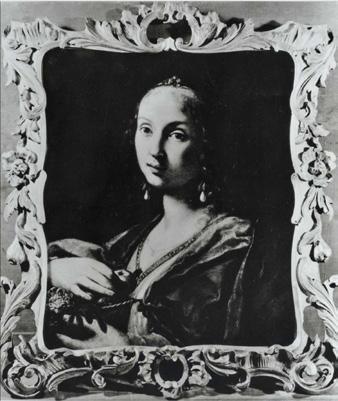
paint surface was lost in the process, this alteration notably replaced the elegantly asymmetrical composition of the original with a more prosaic regularity, one clearly prized by the audience of decades past.

The other variations between the two versions would seem to have been the choice of either artist or subject. While the color of Ortensia’s cloak—a brilliant vermillion backed by a subtle gold—remains the same in both pictures, the blouse beneath is a light blue in the Chazen painting and an olive green in ours. Ortensia has moreover acquired extra jewelry in the Chazen painting, a gold decoration in her hair and a fine necklace across her chest. It is impossible to say whether these were additions or subtractions, whether embellishments to or simplifications of the first version, whichever painting that might have been. We can only assume that two versions of the painting were created by Sirani to accommodate the wishes of the patron Francesco Cordini, who likely kept one of the paintings and gifted the other to a family member or, as Raffaella Morselli has posited, to the Medici family, for whom he served as courtier.7
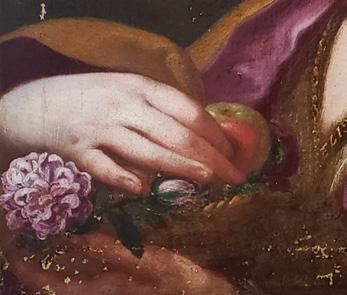
Omnia Vincit Amor (Love Conquers All)
Signed and dated, lower center: ELISAB.TA/ SIRANI F/ 1662
Oil on canvas
33 x 27 inches (83.7 x 68.6 cm)
PROVENANCE
Commissioned by Padre Giovanni Vincenzo Paolini, 1662
Camillo Hercolani, Bologna, before 1677;1 by descent to: Principe Filippo Hercolani, Bologna, by 1713; by descent to:
Astorre Hercolani, Bologna, until sold 5 May 1836
Saul Cohen, Rockville, Connecticut
Christie’s, New York, 3 October 2001, lot 47; where acquired by: Galleria Cantore Antiquaria, Modena, 2001–2004; from whom acquired by: Private Collection, Piacenza, Italy, 2004–2023
EXHIBITED
“La donna nella pittura italiana nel Seicento e Settecento: il genio e la grazia,” Museo di Arti Decorative of the Fondazione Pietro Accorsi, Turin, 28 March – 27 July 2003, no. 86.
“Elisabetta Sirani: “Pittrice Eroina,” 1638–1665,” Museo Civico Archeologico, Bologna, 4 December 2004 – 27 February 2005, no. 99.
“Di Mano donnesca, donne artiste dal XVI al XX secolo,” Palazzo Venezia, Rome, 4 – 14 October 2012.
“Il visibile narrare: Storie di Dei e Uomini nella Collezione Cantore,” Galleria Comunale d’Arte, Cesena, 1 December 2013 – 26 January 2014, no. 16.
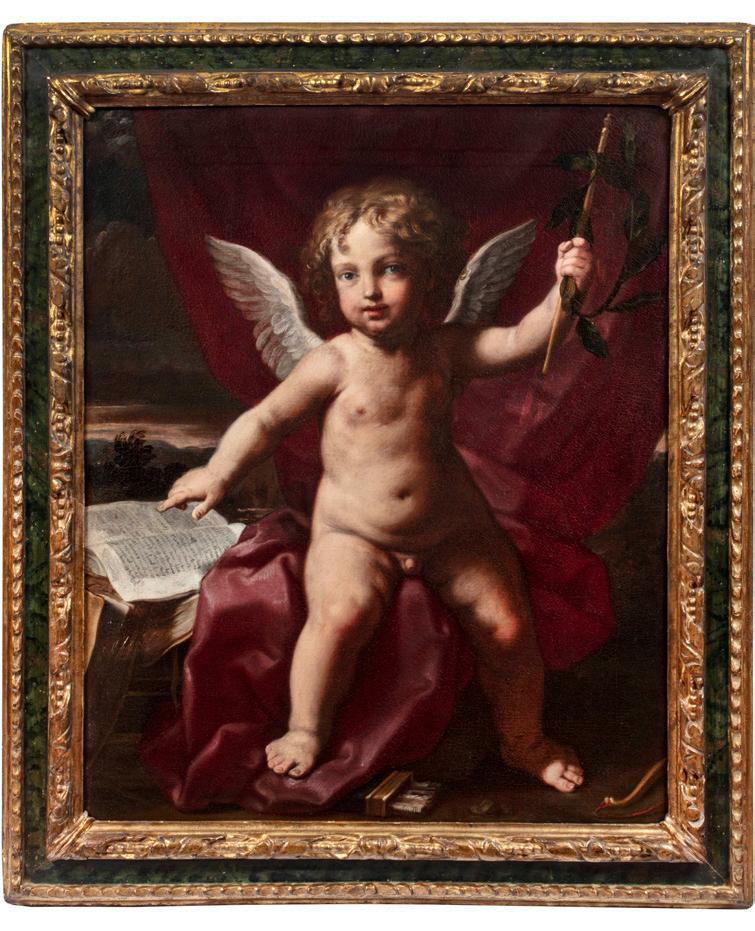
“Elisabetta Sirani: Donna Virtuosa, Pittrice Eroina,” Galleria PBER Banca, Modena, 17 September – 14 November 2021, no. 6.
LITERATURE
Carlo Cesare Malvasia, “Nota delle Pitture fatte da me Elisabetta Sirani,” in Felsina Pittrice: Vite de’ Pittori Bolognesi, Bologna, 1678 (ed. Giampietro
Zanotti, 1841), vol. 2, p. 397.
Jacopo Alessandro Calvi, Versi e Prose sopra una serie di eccellenti pitture possedute dal Sig. Marco Fil. Hercolani, Principe di S.R.I., Bologna, 1780, pp. 62-63.
Petronio Bassani, Guida agli amatori di Belle Arti, architettura, pittura, es cultura per la città di Bologna, Bologna, 1816; cited by Modesti, 2014, p. 308.
Emilia Calbi, Daniela Scaglietti Kelescian, and Marcello Oretti, Marcello Oretti E
Il Patrimonio Artistico Privato Bolognese, Bologna, Biblioteca Comunale, Ms. B. 104, Bologna, 1984, p. 176 [ms. B 104, I, c. 136].
Adelina Modesti, “Alcune riflessioni sulle opere grafiche della pittrice Elisabetta
Sirani nelle raccolte dell’Archiginnasio,” L’Archiginnasio, vol. 96 (2001), pp. 195-196, note 124, fig. 56.
Franco Paliaga, in La donna nella pittura italiana nel Seicento e Settecento: il genio e la grazia, ed. Alberto Cottino, exh. cat., Turin, 2003, pp. 210-211, cat. no. 86.
Armando Audoli, “Passioni e Tormenti Barocchi,” in Grazia, no. 49 (6 December 2004), p. 116.
Irene Graziani, in Elisabetta Sirani: “Pittrice Eroina,” 1638–1665, ed. Jadranka
Bentini and Vera Fortunati, exh. cat., Bologna, 2004, pp. 241-242, cat. no. 99.
Adelina Modesti, Elisabetta Sirani: Una virtuosa del Seicento bolognese, Bologna, 2004, pp. 39 note 89, 128-129, 327 note 99, fig. 66.
Barbara Ghelfi, “Un nuovo inventario della galleria Hercolani nella Biblioteca dell’Archiginnasio,” L’Archiginnasio, vol. 102 (2007), p. 446.
Consuelo Lollobrigida, in Di mano donnesca, donne artiste dal XVI al XX secolo, exh. cat., Rome, 2012, pp. 16-19, fig. 9.
Floriana Conte, “Nota a margine del Ritratto di Vincenzo Ferdinando Ranuzzi di Elisabetta Sirani con qualche riflessione sugli Amori,” Iconographica, vol. 12 (2013), pp. 186-189, fig. 4.
Daniele Benati, in Il visibile narrare: Storie di Dei e Uomini nella Collezione Cantore, ed. Alessandro Giovanardi, exh. cat., Cesena, 2013–2014, pp. 82-83, cat. no. 16.
Adelina Modesti, Elisabetta Sirani ‘Virtuosa’: Women’s Cultural Production in Early Modern Bologna, Turnhout, 2014, pp. 307-308, cat. no. 86.
Lucia Peruzzi, Elisabetta Sirani: Donna Virtuosa, Pittrice Eroina, exh. cat., Modena, 2021, pp. 36-37, cat. no. 6.
Adelina Modesti, Elisabetta Sirani, Los Angeles, 2023, p. 137.
DEPICTIONS OF CHILDREN were favorite subjects for Sirani—perhaps a surprising focus for an artist who never married or had children. Whether
painting the Christ Child, the Infant Saint John the Baptist, allegorical figures, angels, or Cupid, Elisabetta imbued these figures with a combination of seriousness and playfulness. The present work is arguably the most important treatment of such a subject in Sirani’s oeuvre. It is an elaboration of the artist’s earlier composition Cupid Triumphant on the Sea of 1661, which Sirani painted on three occasions—first for the wedding of Cosimo III de’ Medici to Margherita Luisa d’Orléans (Fig. 1), and subsequently in versions for the Cordini and Rizzardi families.
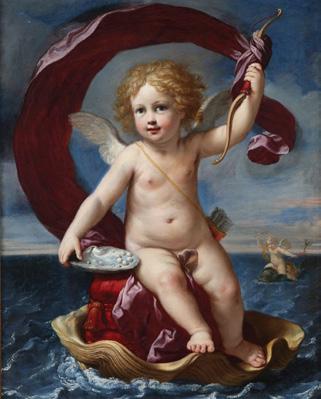
Our painting returns Cupid to land and places him in a landscape seated against crimson drapery. Omnia Vincit Amor is identifiable in Sirani’s list of her works: “A Cupid sitting on red drapery, which acts as a backrest, with his right hand he gestures to some books, holding a scepter and laurel crown in his left hand; for the Father Inquisitor.”2
Adelina Modesti identified Sirani’s patron, the Inquisitor General of Bologna, as Padre Giovanni Vincenzo Paolini da Garessio. While the patron’s vocation undoubtedly influenced the iconography of the painting, there are no overtly religious references in the composition. In fact the subject derives from a wellknown classical source, a passage in Virgil’s Eclogues (X, 69): “Omnia vincit Amor et nos cedamus Amori” or “Love conquers all; let us all yield to love.”
This passage was earlier (and famously) taken up as a subject by Caravaggio in the first years of the 17th century (Fig. 2). His Amor Vincit Omnia rapidly became the object of both praise and controversy in Rome, having given rise to both laudatory poems and virulent criticism, most notably from the artist’s rival Giovanni Baglione.
Sirani was no doubt aware of Caravaggio’s celebrated painting, as she similarly depicts Love triumphant over earthly endeavors, symbolized by a variety of objects scattered across the composition. However her conception of the central figure was quite diverse. In contrast to Caravaggio’s sexualized youth, Sirani’s Cupid is a robust child, his nudity emblematic of virtue and innocence.3 She portrays a joyful winged Cupid, naked but not lurid, engaging directly with the viewer as he proudly demonstrates the superiority of love over earthly pursuits.
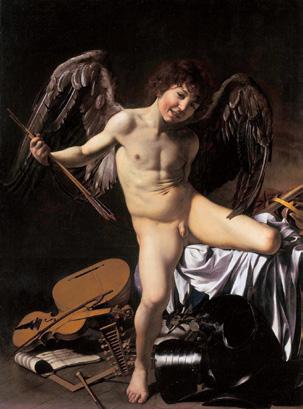
These include erudition, as represented by the jumble of books (one of which is inscribed “PLI[NY]”); military ambitions, signified by the bow at lower right and the quiver full of arrows upon which Cupid rests his foot; and the arts, symbolized by the laurel wreath wrapped around the scepter held aloft by the triumphant child.
Our painting passed from its first owner, Giovanni Vincenzo Paolini, to Camillo Hercolani, who was himself close to the Sirani family (having been a witness at the wedding of Barbara Sirani, Elisabetta’s younger sister).4 It then descended through the main branch of the Hercolani family, where it became the subject of a poem written for the wedding celebrations of Principe Filippo Hercolani and Marchese Corona Cavriani in 1713 (published by Jacopo Alessandro Calvi along with a description of the painting in his Versi of 1780). In the 18th century the Bolognese scholar and collector Marcello Oretti had seen and recorded our painting in the “Casa Hercolani Senatoria dai Servi.” He was the first to call the painting “L’Amore Divino,” or Divine Love, a title by which it frequently appears in the scholarly literature. The painting later hung in the Palazzo Hercolani on the Strada Maggiore in Bologna, now the seat of the University of Bologna, until its sale in 1836.
No drawings by the artist can be associated with the present painting. However, an insight into Sirani’s development of the composition can be had through a pentimento perceptible upon close inspection along the proper left arm of the figure. There a first idea for a bow held by Cupid can be seen beneath the scepter and laurel wreath that we see today.
Madonna and Child
Oil on canvas
14 x 10 ⅝ inches (35.6 x 27 cm)
PROVENANCE
(Possibly) Commissioned by Cardinal Girolamo Farnese as gift for Henrietta
Adelaide of Savoy, Duchess of Bavaria, 1663
Beccari Collection, Italy, by the late 19th century, and by descent to:
Giuseppe Beccari (1943–2021), Reggio Emilia
Private Collection, Naples
Private Collection, Cesena
Private Collection, Modena
Ossimoro Galleria d’Arte, Modena
Private Collection, Piacenza, 2021–2023
LITERATURE
(Possibly) Carlo Cesare Malvasia, “Nota delle Pitture fatte da me Elisabetta
Sirani,” in Felsina Pittrice. Vite de’ Pittori Bolognesi, Bologna, 1678 (ed.
Giampietro Zanotti, 1841), vol. 2, p. 398.
Adelina Modesti, Elisabetta Sirani ‘Virtuosa’: Women’s Cultural Production in Early Modern Bologna, Turnhout, 2014, pp. 42, 309, under cat. no. 88, fig. 65a.
Adelina Modesti, Elisabetta Sirani Pittrice nella Bologna del ‘600, ed. Sergio
Bianchi, Modena, 2022, pp. 64-65, 72.
Adelina Modesti, Elisabetta Sirani, Los Angeles, 2023, p. 137.
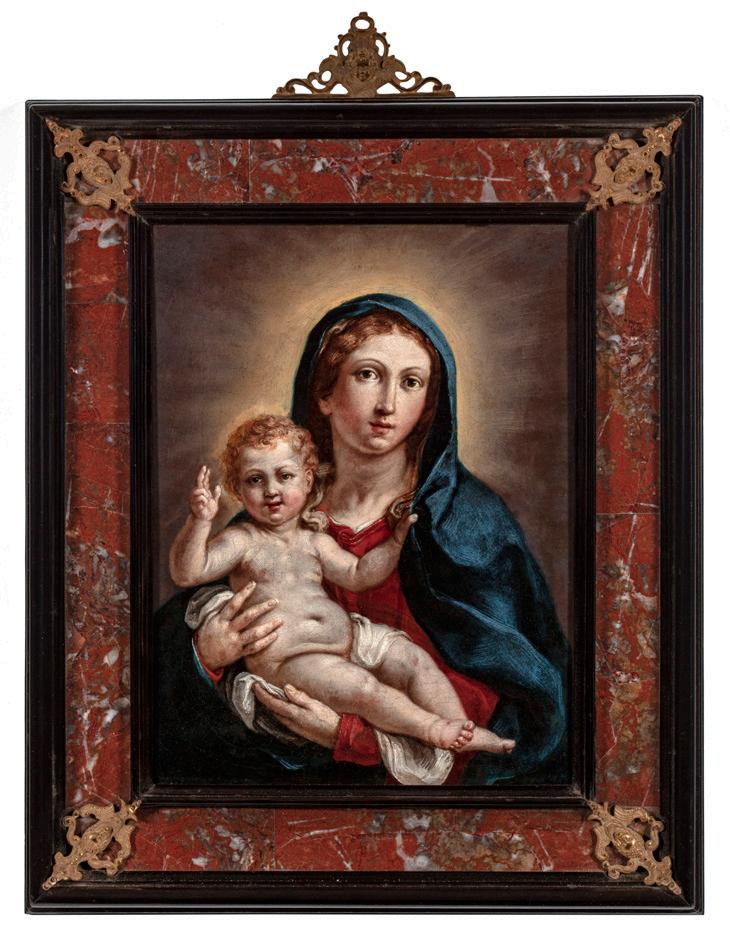
THIS JEWEL-LIKE
Madonna and Child is a striking example of Elisabetta Sirani’s small-scale paintings. Works of this type are known as quadretti da letto, as they were often placed in the private spaces of the home, particularly in bedrooms. The intimacy of our painting, with its intense focus on the figures here placed close to the pictorial plane and brought into close proximity with the viewer, is especially well-suited to a painting intended for private devotion. The Virgin Mary presents the blessing Christ child to the viewer, encouraging both visual engagement and spiritual contemplation. Sirani has emphasized the divinity of these holy figures by painting them against a plain dark background that counterbalances the bright light of their halos.
Working on this small scale, Sirani’s great sensitivity and masterful handling of paint are in full evidence. In addition to displaying an overall brightness associated more with a painting on copper than one on canvas, the subtle rendering of the flesh tones and the deep lapis lazuli blue of the Virgin’s mantle are especially striking. The facial type of the Virgin recurs throughout the artist’s oeuvre and most closely resembles Sirani’s Self-Portrait as an Allegory of Painting of 1658, in which the features are mirrored, with the figure’s head inclining to the left (Fig. 1).
Adelina Modesti has suggested that our Madonna and Child is identifiable with one of two paintings recorded ca. 1662–1663 in Sirani’s list of her works. She associated the picture with two successively described paintings: “A small half figure of a Madonna and Child, who is leaning against her shoulder as she sustains him on her arms, for the signor Cardinal Farnese” and “Another Madonna similar
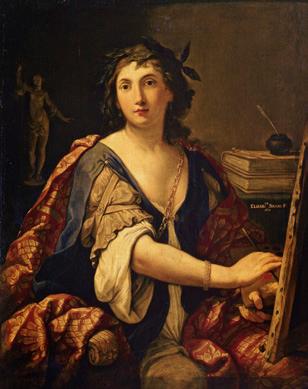
to this one both in scale as in disposition, because this was how he wished it for the Signora Duchess of Baveria.”1
The first of these paintings was commissioned by Girolamo Farnese, Cardinal of Bologna from 1658–1662, and the second by him as a gift for the Duchess of Bavaria, Enrichetta Adelaide of Savoy. Fiorella Frisoni has questioned this identification, pointing out that Christ is described by Malvasia as leaning on the Virgin’s shoulder (“sta appogiato ad una spalla”), which does not exactly correspond with our composition. Frisoni has proposed that Sirani’s paintings for Girolamo Farnese and the Duchess of Bavaria rather refer to a variant composition—one signed and unpublished in a private collection in Italy (Fig. 2) and the other, signed and dated 1663, of slightly smaller dimensions, in a private collection in Venezuela (Fig. 3).2 Our painting dates from the same moment in which the artist was only in her early twenties but had already found great success as a painter of private devotional pictures.
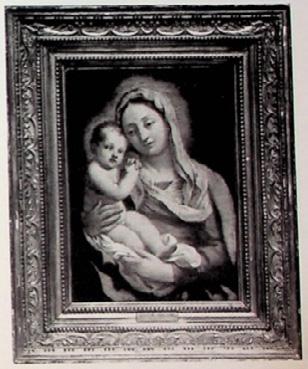
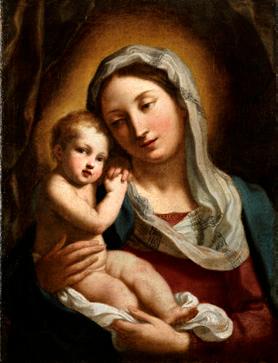
On Loan from a Private Collection Delilah
Signed and dated on the neckline: ELISABETTA/ SIRANI 1664
Oil on canvas
27 x 17 ½ inches (55 x 44.5 cm)
PROVENANCE
Commissioned by Andrea de Buoi, 1664; by whom given to a “Cavaliere Fiorentino”
Private Collection, France
Brissoneau-Daguerre, Paris, 4 November 2011, lot 24
Private Collection, Italy
Robert Simon Fine Art, New York, 2014; from whom acquired by:
Private Collection, Connecticut
EXHIBITED
“By Her Hand: Artemisia Gentileschi and Women Artists in Italy, 1500–1800,”
Wadsworth Atheneum, 30 September 2021 – 9 January 2022, and
Detroit Institute of Arts, 6 February – 29 May 2022, no. 42.
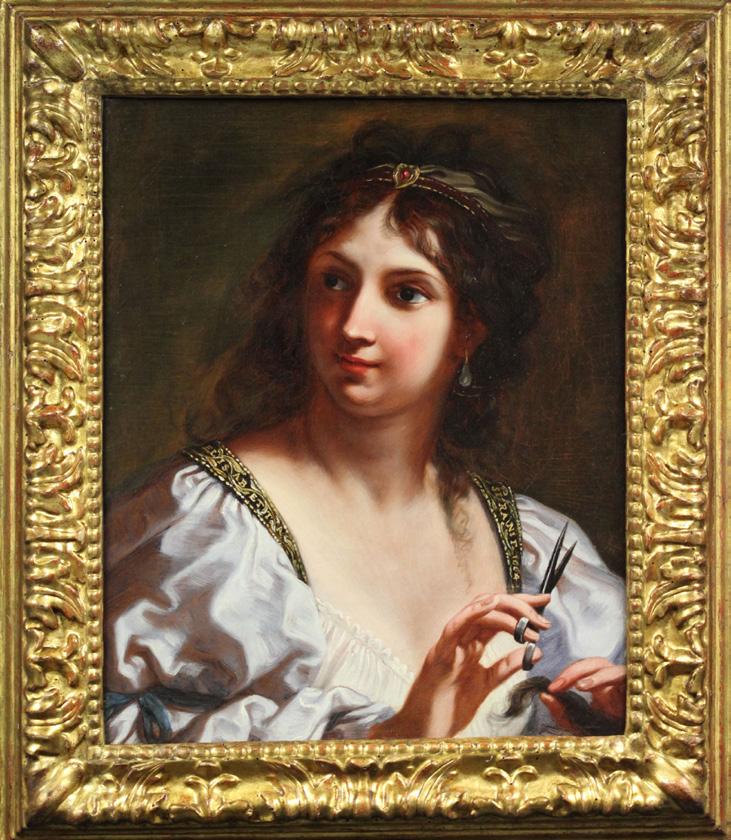
LITERATURE
Carlo Cesare Malvasia, “Nota delle Pitture fatte da me Elisabetta Sirani,” in Felsina Pittrice: Vite de’ Pittori Bolognesi, Bologna, 1678 (ed. Giampietro Zanotti, 1841), vol. 2, p. 399.
Fiorella Frisoni, “Elisabetta Sirani,” in La Scuola di Guido Reni, ed. Emilio Negro and Massimo Pirondini, Modena, 1992, p. 347.
Adelina Modesti, Elisabetta Sirani ‘Virtuosa’: Women’s Cultural Production in Early Modern Bologna, Turnhout, 2014, pp. 223, 342, no. 118, fig. 90.
Eve Straussman-Pflanzer in By Her Hand: Artemisia Gentileschi and Women
Artists in Italy, 1500–1800, ed. Eve Straussman-Pflanzer and Oliver
Tostmann, exh. cat., New Haven and London, 2021, pp. 140-141, cat. no. 42.
Babette Bohn, Women Artists, Their Patrons, and Their Publics in Early Modern Bologna, University Park, PA, 2021, pp. 67-69, 71, 148, fig. 35.
Adelina Modesti, Elisabetta Sirani, Los Angeles, 2023, pp. 81-82, 99, 137, fig. 56.
SIGNED AND DATED 1664, the present picture can be identified with a “testa di Dalida” (Head of Delilah) commissioned that year by one Andrea de Buoi, as recorded in Sirani’s list of her works. The story of Samson and Delilah is recounted in the Old Testament (Judges 16:4-20). Seeking to bring about Samson’s downfall, the Philistines bribed his lover Delilah, herself a Philistine, to persuade Samson to reveal the secret of his great strength. Although he lied to her three times, he eventually revealed that it lay in his hair and so, having lulled him to sleep, Delilah signaled to a Philistine lying in wait outside to cut his hair. In depictions of the story, it is often Delilah who is shown holding the scissors, as is the case here.
The portrayal of strong or virtuous women from the Bible or Antiquity was popular in 17th-century Bologna. And for Elisabetta Sirani there must have been personal overtones, expressed through her several depictions of these heroines.
They range from large-scale works, including her Judith and Holofernes of 1658 (Burghley House, Stamford), Timoclea of 1659 (Museo di Capodimonte, Naples), and Porzia of 1664 (Cassa di Risparmio, Bologna), to smaller, single-figure representations such as Cleopatra (Flint Institute of Arts, Flint), Circe (Antichità il Leone, Bologna), Iole of 1661 (Cassa di Risparmio, Bologna), and a second,
earlier Delilah of 1657 (Fig. 1). These figures often follow an idealized female type with rounded features which Sirani favored. The present work, for example, may be compared to two paintings produced in the same year—Sirani’s Galatea (Private Collection, Modena) or the central figure in Justice, Charity and Prudence (Comune di Vignola, near Modena).
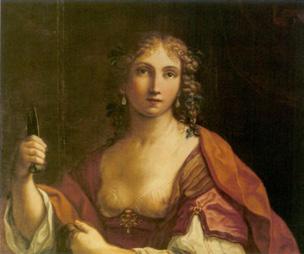
On Loan from a Private Collection
Portrait of Anna Maria Ranuzzi as Charity
Signed and dated on the sleeve: ELISA.TA SIRANI. F. 1665
Oil on canvas
35 ⅜ x 30 ½ inches (90.5 x 77.5 cm)
PROVENANCE
Commissioned by Count Annibale Ranuzzi, 1665, Palazzo Ranuzzi, Bologna, until at least 1698
Durst Family Collection, Budapest, until 1919, then Vienna; thence by descent to:
Robert and Paula Zalaudek Durst, Vienna, until 1936, then New York, until 1985; by descent to her niece: Gertrude Hounsell, New York
Robert Simon Fine Art, New York, 2016; from whom acquired by: Private Collection, Connecticut
EXHIBITED
“By Her Hand: Artemisia Gentileschi and Women Artists in Italy, 1500–1800,” Wadsworth Atheneum, 30 September 2021 – 9 January 2022, and Detroit Institute of Arts, 6 February – 29 May 2022, no. 44.
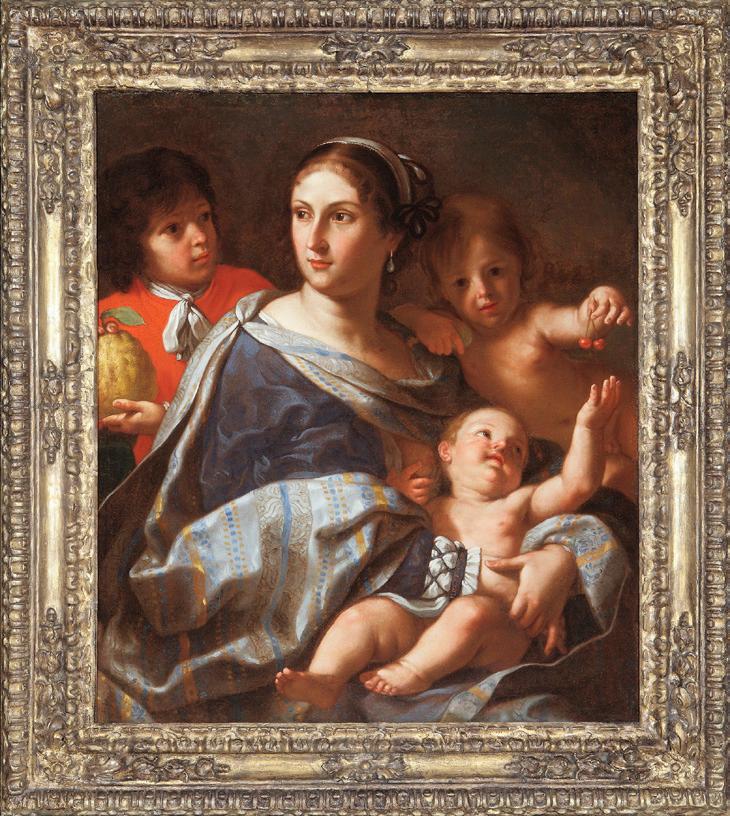
LITERATURE
Carlo Cesare Malvasia, “Nota delle Pitture fatte da me Elisabetta Sirani,” in Felsina Pittrice: Vite de’ Pittori Bolognesi, Bologna, 1678 (ed. Giampietro Zanotti, 1841), vol. 2, p. 400.
Babette Bohn, Women Artists, Their Patrons, and Their Publics in Early Modern Bologna, University Park, PA, 2021, pp. 83, 85, 259, note 53, fig. 47.
Eve Straussman-Pflanzer in By Her Hand: Artemisia Gentileschi and Women
Artists in Italy, 1500–1800, ed. Eve Straussman-Pflanzer and Oliver
Tostmann, exh. cat., New Haven and London, 2021, pp. 144-145, cat. no. 44.
Adelina Modesti, Elisabetta Sirani, Los Angeles, 2023, pp. 77, 89, 91-92, 103, 104, 138, fig. 61.
THIS PORTRAIT of Anna Maria Ranuzzi in the guise of Charity is one of two versions painted by Elisabetta Sirani for the Ranuzzi family of Bologna. It is notable both as one of the last paintings the artist completed before her untimely death in August 1665 and as one of only two known female portraits with identified sitters—the other being the Portrait of Ortensia Leoni Cordini (see catalogue number 1).
Our portrait and its counterpart, now in the collection of the Cassa di Risparmio in Bologna (Fig. 1), were commissioned by Count Annibale Ranuzzi—a Bolognese senator and a frequent patron of Sirani. The two paintings are identically signed and dated, depicting Annibale’s sister with her two children, Silvio and Francesco Maria. The third child is not a portrait, but rather serves to establish the subject following the iconographical scheme laid out by Carlo Cesare Ripa, who writes that Charity is traditionally shown surrounded by three children for whom she cares.
The concept of representing Anna Maria as Charity, the greatest of the three theological virtues after Faith and Hope, was Sirani’s own. She records the work in her list as “A Charity, for which I wanted to portray the same Signora Anna Maria Ranuzzi as a most beautiful Lady, and similarly her children Silvio and Francesco Maria, the third having been added on a whim, and this for the most illustrious Count Annibale Ranuzzi brother of the Signora.”1 Sirani clearly had an interest in allegorizing her portraiture, which was fashionable in the period. In addition to depicting Ortensia Leoni Cordini as Saint Dorothy, she painted a portrait of the young Vincenzo Ferdinando RanuzziCospi as Cupid (Muzeum Narodowe, Warsaw), and self-portraits in the guises of a female saint (Pinacoteca Nazionale, Bologna), an Allegory of Painting (Pushkin Museum, Moscow), and Judith (Burghley House, Stamford).
Both our portrait and the version in the Cassa di Risparmio are recorded in the inventory of Count Annibale Ranuzzi compiled in 1698. One painting is mentioned as being in room 15 of the Palazzo Ranuzzi, and the other, described as a “copy of the charity with Putti by La Sirani,” was noted in a closet or picture cabinet.2 Later Ranuzzi inventories list only one version of the portrait— identifiable as the version still in Bologna, which can be traced from the family to its current ownership. Our portrait must have left the collection by the end of the 18th century.
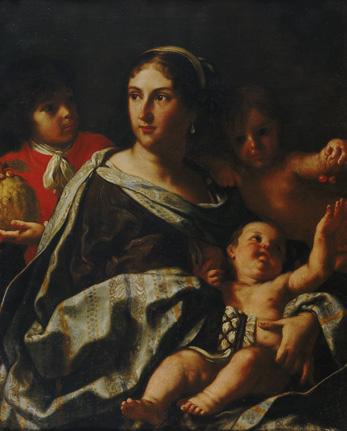
Both versions of the portrait are signed and dated 1665 and are virtually identical in composition and execution. The Bologna version is characterized by a dark and dramatic chiaroscuro as opposed to the brighter palette seen in the present painting, although this difference may be the consequence of their varied conservation histories.
Elisabetta Sirani’s Portrait of Anna Maria Ranuzzi had great currency in Bologna in the decade in which it was painted. The composition served as inspiration for a Holy Family and a recently re-emerged variation on the portrait, both of which have been attributed to Sirani’s student Lucrezia Scarfaglia.3 A rare etching by the little-known Bolognese artist Carlo Girolamo Castelli in the Albertina, Vienna— inscribed “Elis. Sirani Inv.”—records what appears to be a further variation on the portrait in which the principal figure wears a turban.4
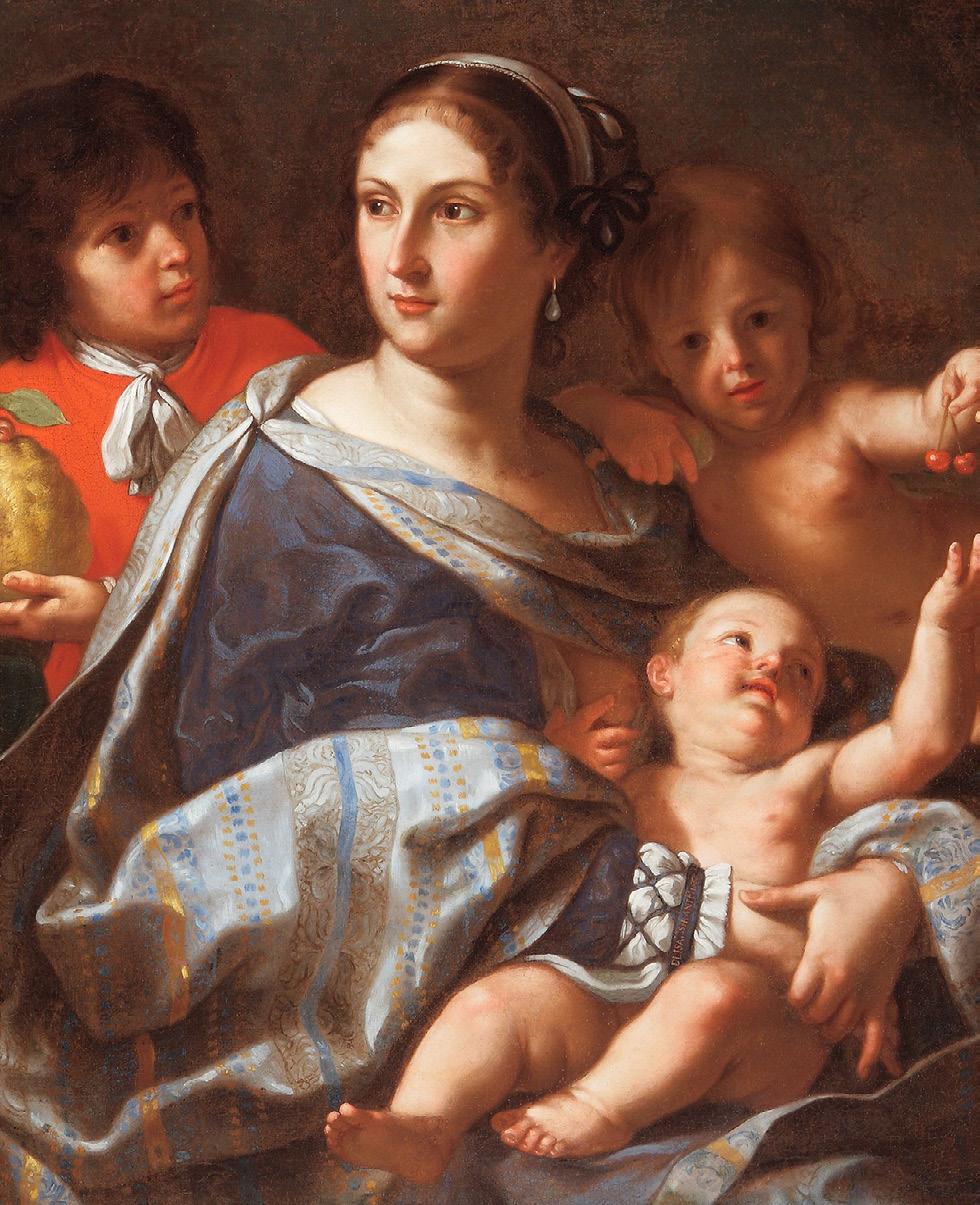
The Temptation of Christ
Pen and ink with wash over black chalk on paper
6 ⅛ x 3 ¾ inches (15.5 x 9.5 cm)
PROVENANCE
Jules-Alexandre Duval Le Camus, Paris (Lugt 1441); by descent to his daughter: Berthe Bathilde Duval Le Camus and her husband Georges Victor Antoine
Gratet-Duplessis, Paris
Probably sold in Jules-Alexandre Duval Le Camus’s estate sale; Maurice Delestre, Paris, 9 January 1879, “Vente D’Après Déces De M. X***, Artiste Peintre”
Private Aristocratic Collection, France, from the late 19th century Private Collection, London
AS DISTINGUISHED AS SIRANI was as a painter, she was equally celebrated as a draughtswoman. Her graphic oeuvre is the largest of any female artist in early modern Italy, and the majority of her drawings, like the present one, are rendered in her highly individual style and technique. Sirani rapidly executed her drawings, putting her ideas to paper with incisive strokes of chalk followed by loose application of ink wash with a brush, lending an especially painterly verve to her compositions. Her biographer Malvasia observed her distinctive method firsthand, writing of Sirani’s talent: “I can truthfully say, having been present many times when some commission for a painting came, she quickly took the chalk, and placing the sketch down swiftly in two marks on white paper (this was the great master’s only method of drawing, which was practiced by few, not even by her father...), dipped a small brush in ink wash; from this quickly appeared
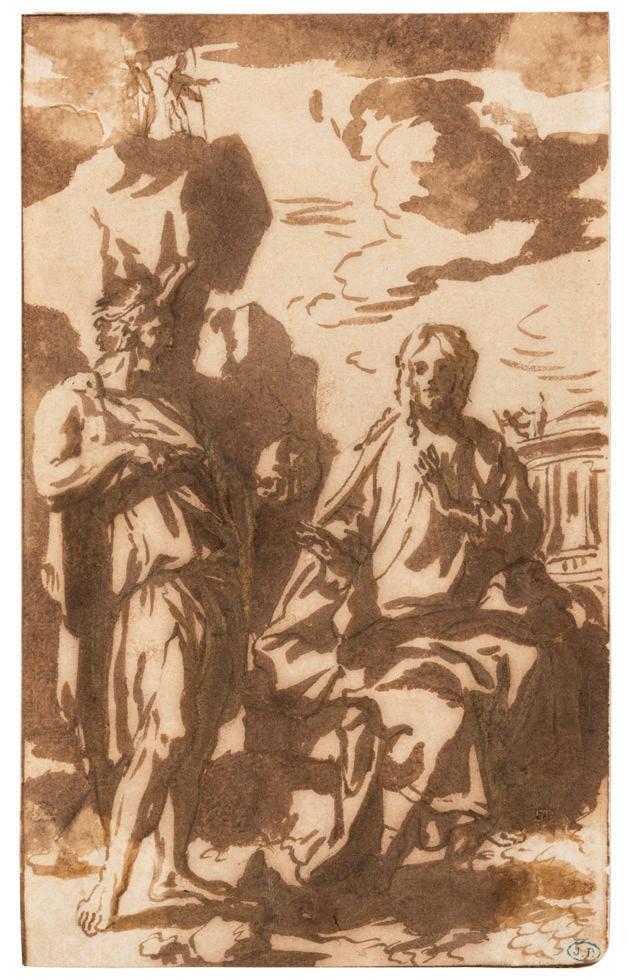
a spirited invention that seemed to be without drawn or shaded strokes, and heightened together all at once.”1
Our drawing depicts the temptation of Christ as described in the New Testament (Matthew 4:1-11). Sirani has synthesized the three scenes of this rarely depicted Biblical narrative—in which Christ is tempted three times by the devil—into a single, concise composition. The episodes play out successively in different registers and planes of the image—beginning in the foreground, followed by the right background, and finally in the upper left. The central focus of the drawing is the first temptation, in which Satan appears to Christ while he was fasting in the wilderness and tells him: “If You are the Son of God, command that these stones become bread.” Satan appears almost as a classical figure, standing in subtle contrapposto while holding a large stone in his hand and pointing at those on the ground at the lower edge of the sheet. Christ, seated at right, throws up his hands as if in the moment of delivering his response: “Man shall not live on bread alone, but on every word that comes out of the mouth of God.” The second temptation is depicted just above Christ’s shoulder atop a classical building. The devil goads Christ to jump from the top of the temple, saying that if he is the son of God, angels will fly down to save him. Interestingly, the diminutive Satan here is the one jumping off the temple, as he is rebuked again by Christ and seemingly begins to fly off towards the third temptation. At the mountain’s peak, the devil points out over the land, promising Christ all the kingdoms of the earth if he will bend to worship him, but again is unsuccessful.
The subject does not correspond to any known painting recorded in Sirani’s list of her works. This suggests that the drawing might have been preparatory for a project never completed or simply drawn as a design unto itself. Regardless, the drawing beautifully showcases not only Sirani’s technical bravura, but also her ability to capture the full scope of a narrative within a single composition. Here the sketchy black chalk underdrawing is only faintly visible beneath the masterful application of different tones of wash. The passages of wash in turn contrast and combine beautifully with the areas left in reserve, creating brilliant
modeling and light effects. The freedom and animation of the drawing finds close comparables throughout Sirani’s oeuvre, as with her Seated Woman with a Winged Putto in the Royal Collection (Fig. 1). The treatment of the seated figure’s individual locks of hair, the weight and folds of the flowing drapery, as well as the expressive hand gestures parallel those of the main figure of Christ in our drawing.
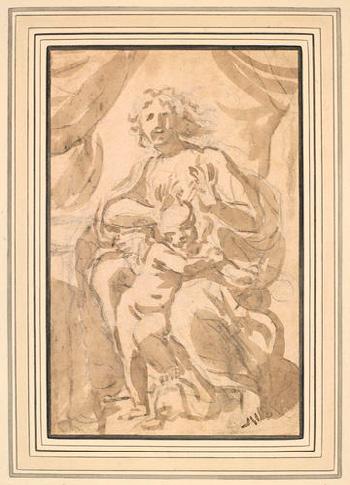
Our drawing was formerly in the collection of the 19th-century French painter Jules Alexandre Duval Le Camus (1814–1878). Jules was the son of Pierre Duval Le Camus (1790–1854), a pupil of Jacques-Louis David, and he must have first trained with his father before
studying under Paul Delaroche and Martin Drolling. He painted primarily religious and historical subjects, winning second prize in the Prix de Rome of 1838 and exhibiting at the Salon from 1840 through 1867. He assembled a significant collection of drawings that was dispersed by his daughter following his death. The present work has recently re-emerged from a French aristocratic collection, in which it has resided since the 19th century.
Head of a Youth
Inscribed, lower right: Sirani
Colored chalks with pastel and white heightening on paper
12 ⅝ x 9 3/16 inches (32.1 x 23.3 cm)
PROVENANCE
(Possibly) Lorenzo Zacconi, Bologna, by 1677
Private Collection, New York
Mia N. Weiner, Norfolk, Connecticut, 2008–2009; where acquired in 2009 by: Linda Cheverton Wick and Walter Wick, 2009–2023.
EXHIBITED
“By Her Hand: Artemisia Gentileschi and Women Artists in Italy, 1500–1800,” Wadsworth Atheneum, 30 September 2021 – 9 January 2022, and Detroit Institute of Arts, 6 February – 29 May 2022, no. 46.
LITERATURE
Neil Jeffares, Dictionary of Pastellists before 1800, Online Edition, updated 29 October 2021, www.pastellists.com, “Sirani, Elisabetta,” cat. no. J.68.102.
Adelina Modesti, Elisabetta Sirani ‘Virtuosa’: Women’s Cultural Production in Early Modern Bologna, Turnhout, 2014, pp. 121, 379, fig. 117.
Babette Bohn, Women Artists, Their Patrons, and Their Publics in Early Modern Bologna, University Park, PA, 2021, pp. 195-196, 274 note 66, fig. 117.
Oliver Tostmann in By Her Hand: Artemisia Gentileschi and Women Artists in
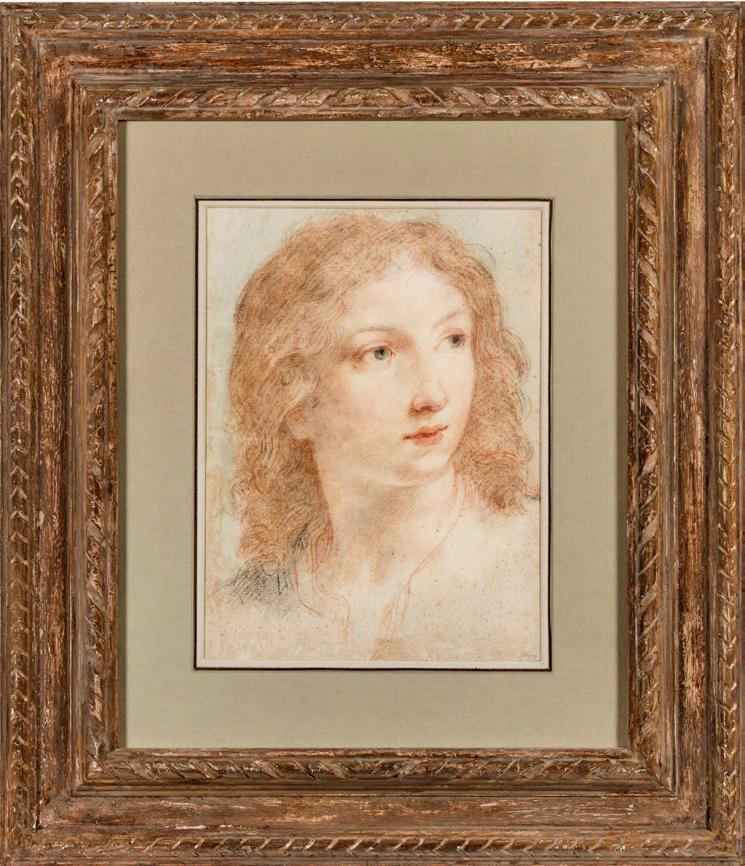
Italy, 1500–1800, ed. Eve Straussman-Pflanzer and Oliver Tostmann, exh. cat., New Haven and London, 2021, pp. 148-149, cat. no. 46. Adelina Modesti, Elisabetta Sirani, Los Angeles, 2023, pp. 47, 49, fig. 29.
THIS SENSUOUS Head of a Youth belongs to a rare group of drawings by Sirani made with a combination of colored chalks and pastel. The two others known today are in the Uffizi (Fig. 1)1 and the Louvre (Fig. 2).2 While several such works in pastel are recorded in early Bolognese inventories, only these have survived.3 The documentation of such works by Sirani points to a continued local taste for them in her native city. Adelina Modesti has suggested that our work is identifiable with the “Testa d’un giovine” (Head of a youth) recorded in Lorenzo Zacconi’s inventory of 1677 (no. 64).4
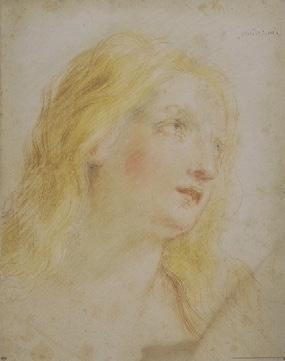
While the young and expressive figures in our work and the Uffizi and Louvre examples were manifestly drawn from life, they are nonetheless idealized, infused with the elegant aesthetic that informs the artist’s work in all media. Although our sheet is clearly a finished work of art in its own right, Babette Bohn considers it also to have been preparatory for Elisabetta’s oil of the young Christ the Redeemer
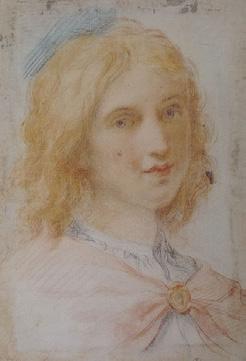 Fig. 1. Elisabetta Sirani, Head of a Youth, Uffizi, Florence.
Fig. 1. Elisabetta Sirani, Head of a Youth, Uffizi, Florence.
of 1664 in the collection of the Cassa di Risparmio in Bologna (Figs. 3-4).5 In a similar vein, the Louvre Head of a Young Woman has been associated with Sirani’s 1664 oil of the Penitent Magdalene. 6 These works clearly served dual functions— as preparatory for paintings and as independent works of art. And with both, revisions to the composition were made in the finished oils, whether minor, such as the covering of ears with hair or the direction of the gaze, or more substantial, as with the reorienting of the torso in the Redeemer.
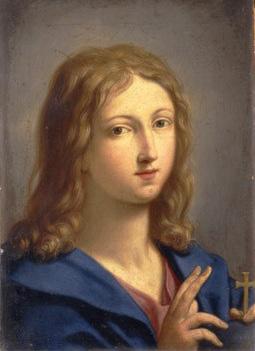
Sirani’s Head of a Youth was recently exhibited in the acclaimed exhibition “By Her Hand: Artemisia Gentileschi and Women Artists in Italy, 1500–1800” at the Wadsworth Atheneum and the Detroit Institute of Arts in 2021/2022. Oliver Tostmann, co-curator of the exhibition, wrote of this work:
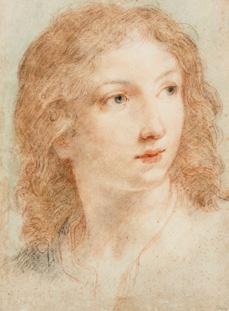

“Sirani’s concern for the play of light is evident in the fine modeling of the face and the swirling, soft hair. With light falling from the right, she used darker chalks to give the face its contours. Soft hatchings accentuate a few details, such as parts of the chin or the eye socket, and red, white, and brown chalks heighten the rest of the face. Eventually, she went over some areas, perhaps with a piece of cloth or a finger, to stump the colors and to create subtle gradations of shadows. Quick and loosely applied lines in red and brown give the face its vivacity. She finished the drawing by added a subtle blue halo. With this intricate technique, Sirani achieved a decidedly painterly effect that has retained an attractive freshness and a subtlety similar to that of pastel.”7
On Loan from the David Owsley Museum of Art
Study for the Madonna di Loreto with Saints Thomas of Villanova, Bernardino of Siena, Lawrence, Francis, and Peregrine
Red chalk and brown wash on paper
6 ⅞ x 4 3/16 inches (17.4 x 10.6 cm)
PROVENANCE
Giuseppe Vallardi, Milan, Italy (Lugt 1223)
Carlo Prayer, Milan, Italy (Lugt 2044)
Maria Shira Lelia de Bernasconi, Lugano, Switzerland, 1977–1986
Christie’s, London, 1 April 1987, lot 67; where acquired by:
Ann Sutherland Harris, Pittsburgh, Pennsylvania; her sale, Christie’s, New York, 30 January 2018, lot 35; where acquired by:
David Owsley Museum of Art, Ball State University, Muncie, Indiana (2018.005.000)
EXHIBITED
“Elisabetta Sirani: “Pittrice Eroina,” 1638–1665,” Museo Civico Archeologico, Bologna, 4 December 2004 – 27 February 2005, no. 116.
“Pittsburgh Collects: European Drawings, 1500 to 1800,” Pittsburgh, Frick Art & Historical Center, 23 October 2004 – 2 January 2005, no. 39.
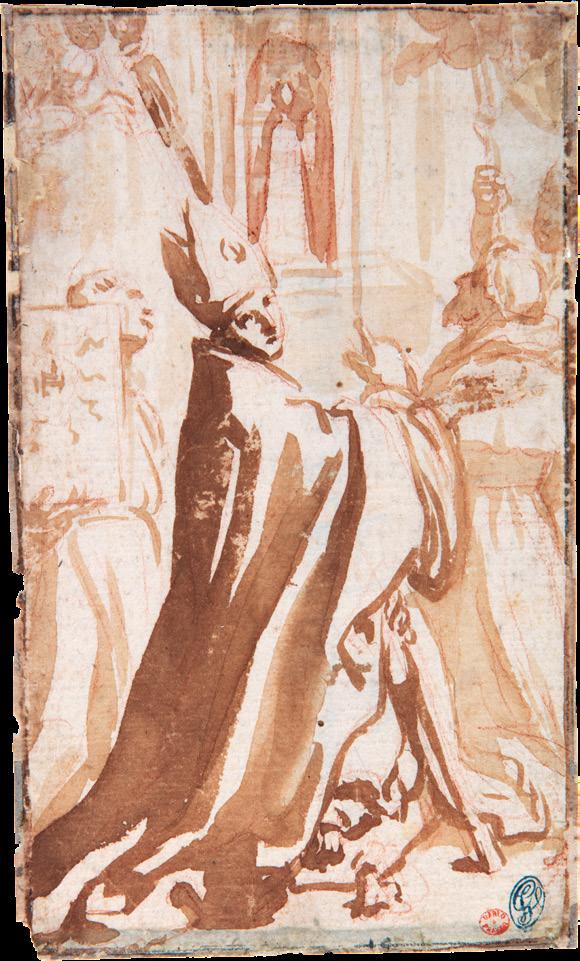
LITERATURE
Babette Bohn, in Pittsburgh Collects: European Drawings, 1500 to 1800, exh. cat., Pittsburgh, 2004, pp. 94-95, cat. no. 39.
Babette Bohn, “Elisabetta Sirani and Drawing Practices in Early Modern Bologna,” Master Drawings, vol. 42, no. 3 (2004), pp. 217-218, 233 note 42.
Babette Bohn, in Elisabetta Sirani: “Pittrice Eroina,” 1638–1665, ed. Jadranka
Bentini and Vera Fortunati, exh. cat., Bologna, 2004, p. 256, cat. no. 116.
Catherine Loisel, Musée du Louvre. Inventaire général des dessins italiens. Tome X, Dessins bolonais du XVIIe siècle, vol. 2, Paris, 2013, p. 512, under no. 941.
Adelina Modesti, Elisabetta Sirani ‘Virtuosa’: Women’s Cultural Production in Early Modern Bologna, Turnhout, Belgium, 2014, pp. 315-316, cat. no. 93.
Babette Bohn, Women Artists, Their Patrons, and Their Publics in Early Modern Bologna, University Park, PA, 2021, pp. 196, 199, fig. 122.
THIS BRILLIANT DRAWING is one of only a handful by Sirani that can be connected to a finished painting. It is in fact one of three studies for an altarpiece dedicated to the Madonna of Loreto in the Church of San Giacomo Maggiore in Castelfranco Emilia (Fig. 1), a town midway between Modena and Bologna. The commission for the work came from Lorenzo Zacconi, a Bolognese nobleman, who installed the painting in his family’s chapel, where it remains today.1 Zacconi was a significant patron of Sirani and was likely the owner of Sirani’s Head of a Youth (see catalogue number 7).
Sirani’s study focuses on the figure of Saint Thomas of Villanova, who served as Archbishop of Valencia and who is here portrayed wearing his mitre, holding a crosier, and draped in a magnificent cope—the folds of which are boldly articulated by powerful brushstrokes of brown wash. To his left appears Saint
Bernardino of Siena holding his traditional emblem of Christ’s monogram, while at the right Saint Francis is seen turned toward the statue of the Madonna high in the distance. The head of another figure appears behind him.
While focusing on the figure of Thomas of Villanova, the drawing serves as an early compositional study for the altarpiece. As the composition evolved Sirani would group paired saints on either side of Thomas, while giving greater prominence to the statue of the Madonna of Loreto, as seen in a related study in the Louvre (Fig. 2) and in the finished altarpiece.
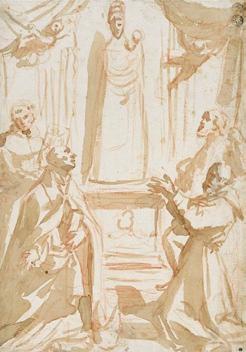
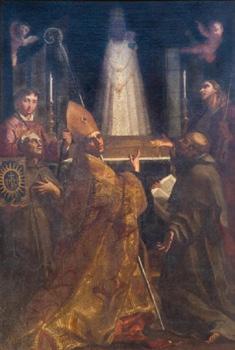
Madonna of Sorrows with Symbols of the Passion
Signed on the plate, lower right: Elisabta Sirani .F. d.d. 1657
Etching
11 ¼ x 8 ⅛ inches (28.6 x 20.7 cm)
PROVENANCE
Private Collection, UK, until 2023.
LITERATURE
Carlo Cesare Malvasia, “Nota delle Pitture fatte da me Elisabetta Sirani,” in Felsina Pittrice: Vite de’ Pittori Bolognesi, Bologna, 1678 (ed. Giampietro
Zanotti, 1841), vol. 2, p. 394.
Adam von Bartsch, Catalogue raisonné des estampes gravées a l’eau-forte, par Guido Reni, et de celles de ses disciples Simon Cantarini, dit le Pesarese, Jean-André et Elisabeth Sirani, et Laurent Loli, Vienna, 1795, pp. 83-84.
Adelina Modesti, “Alcune riflessioni sulle opere grafiche della pittrice Elisabetta
Sirani nelle raccolte dell’Archiginnasio,” L’Archiginnasio, vol. 96 (2001), pp. 162-164, fig. 8.
Adelina Modesti, Elisabetta Sirani: Una virtuosa del Seicento bolognese, Bologna, 2004, pp. 89, fig. 47.
Adelina Modesti, Elisabetta Sirani ‘Virtuosa’: Women’s Cultural Production in Early Modern Bologna, Turnhout, 2014, pp. 229-230, fig. 131.
Irene Graziani, in Elisabetta Sirani: “Pittrice Eroina,” 1638–1665, ed. Jadranka
Bentini and Vera Fortunati, exh. cat., Bologna, 2004, pp. 250, 271.
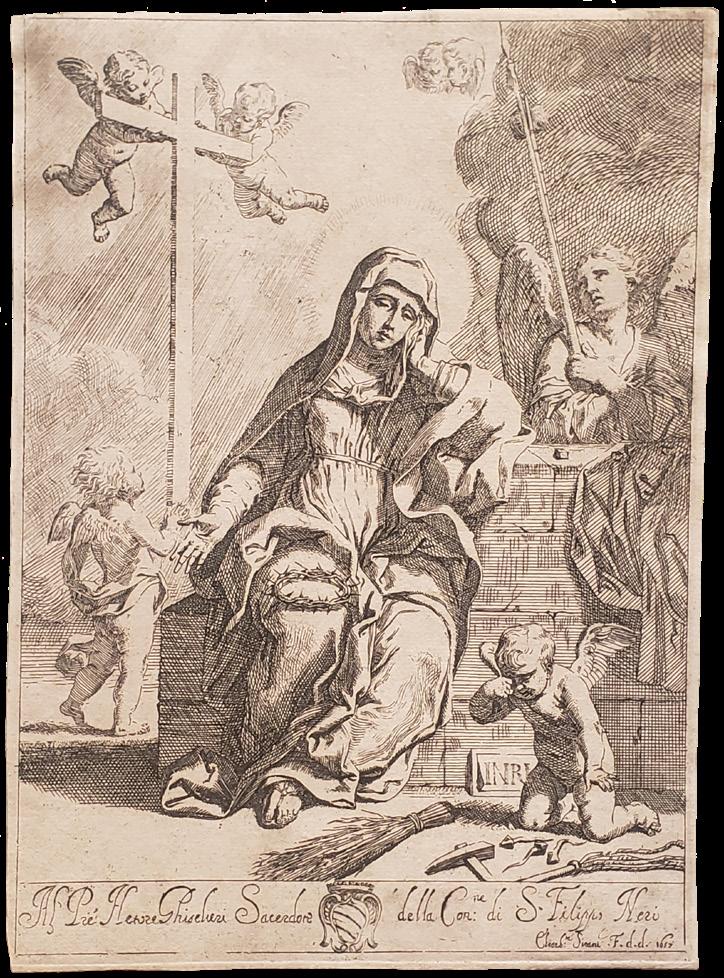
Babette Bohn, Women Artists, Their Patrons, and Their Publics in Early Modern Bologna, University Park, PA, 2021, p. 131.
Adelina Modesti, Elisabetta Sirani, Los Angeles, 2023, pp. 45-46, fig. 27.
ELISABETTA SIRANI HAS THE DISTINCTION of being the earliest known female painter-engraver in Europe, and the only one whose prints have survived. Sirani was also the first female printmaker in her native city of Bologna. She created ten etchings, all of religious subjects, across her career. Malvasia, who collected Sirani’s prints, records that she etched only infrequently as a pastime, and the small number of surviving etchings speaks to the fact that this was a minor part of her production. However few prints she produced, it is evident that Sirani was as skilled with an etching needle as she was with a brush and a pen.
The present etching records Sirani’s painting of the Madonna of Sorrows with Symbols of the Passion, an early work on copper from 1657 that depicts the Virgin and angels mourning the death of Christ (Fig. 1). This painting, one of Sirani’s most impressive and best known private devotional works, was made for Padre Ettore Ghisilieri, a priest at the Church of the Madonna di Galliera and one of Sirani’s most important early patrons. Before joining a religious order, Ghisilieri founded a life drawing academy at his palazzo, which was run by Elisabetta’s father—an association that would lead to several commissions from the young
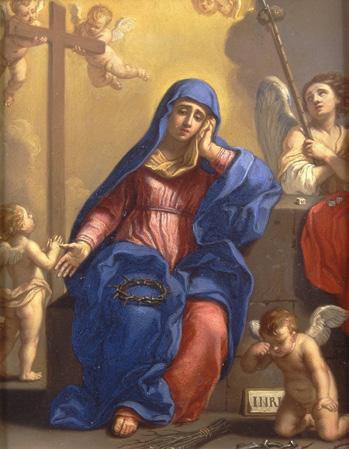
artist. Ghisilieri kept these paintings by Elisabetta in his private apartments in the Oratory attached to the church. A preparatory drawing for the painting, which served as the basis for the print but differs in dimensions and shows no signs of transfer, is in the Staatsgalerie, Stuttgart (Fig. 2).1
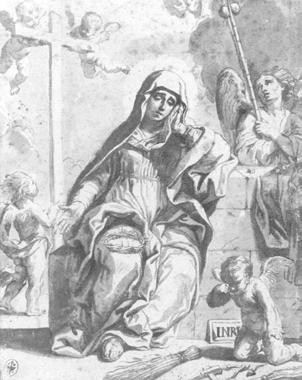
Sirani produced the etching as a presentation print for her patron, to whom it is dedicated: “Al Pre’ Hetore Ghisilieri Sacerdote della Con.ne di .S. Filippo Neri” (To the Prior Ettore Ghisilieri Priest at the Congregation of San Filippo Neri). She also proudly signed it “Elisab:ta Sirani .F. d.d.,” meaning “I made it and dedicated it.” This etching was clearly a work of significance to the artist, as it was one of only two prints that she recorded making. Her 1657 work book entry describes the painting and the etching together: “For Father Ettore Ghisilieri, priest at the Madonna di Galliera, a copper [painting] with the Blessed Virgin contemplating the crown of thorns, and various small Angels contemplating other instruments of the Passion, and I also incised it in copperplate.”2
Amongst Sirani’s prints, the Madonna of Sorrows with Symbols of the Passion was singled out by Adam Bartsch—the foundational scholar of printmaking—as the artist’s most masterful.3 The technique of etching was especially suited to an artist of such virtuosity and allowed for Sirani’s painterly style to transmit beautifully in her prints. This work captures the bold modeling, expressive brushwork, and the subtleties in the play in light and shadow in Sirani’s painting and preparatory drawing, while also creating an entirely new and equally accomplished work of art.
Endnotes
Introduction
1 Elisabeth Sirani, Cleopatra, ca. 1662–1665, oil on canvas, 37 ¼ x 29 ¾ inches (99.7 x 75.6 cm), Flint Institute of Arts, Flint, Michigan (2002.53).
Gift of the Hurand family in memory of Dr. Ben Bryer. See: Adelina
Modesti, Elisabetta Sirani ‘Virtuosa’: Women’s Cultural Production in Early Modern Bologna, Turnhout, Belgium, 2014, p. 326, cat. no. 104, fig. 78.
2 Elisabeth Sirani, Virgin in Prayer, oil on canvas, 41 x 35 ½ inches (104 x 90 cm), Jane Fortune Collection, Indianapolis, Indiana. See: Adelina
Modesti, Elisabetta Sirani ‘Virtuosa’, p. 368, cat. no. 139, fig. 105. “Maestra”
1 Elisabetta Sirani, Self-Portrait, ca. 1658, black and red chalk on paper, sheet: 9 x 6 1/16 inches. Purchased with the Diane A. Nixon, class of 1957, Fund, and the gift of the Almathea Charitable Foundation, Smith College Museum of Art, Northampton, Massachusetts (SC 2020.7.1). Not included in the present exhibition; to be shown in “Making Her Mark: A History of Women Artists in Europe, 1400–1800” at the Baltimore Museum of Art, 1 October 2023 – 7 January 2024, and the Art Gallery of Ontario, 30 March –1 July 2024.
1 Carlo Cesare Malvasia, “Nota delle Pitture fatte da me Elisabetta Sirani,” in Felsina Pittrice: Vite de’ Pittori Bolognesi, Bologna, 1678 (ed. Giampietro
Zanotti, 1841), vol. 2, p. 396. “…per il sig. Francesco Cordini Fiorentino, al quale anco feci il ritratto della moglie in una testa significante santa Dorotea.”
1. Portrait of Ortensia Leoni Cordini as Saint Dorothy2 For a full discussion see: Adelina Modesti, “La Donne Virile,” in Elisabetta
Sirani: Una virtuosa del Seicento Bolognese, Bologna, 2004, pp. 269-271.
3 Modesti, “La Donne Virile,” pp. 227-268.
4 Giovanni Luigi Piccinardi, La Poesia Muta Celibrata della Pittrice
Loguace, Bologna, 1666, p. 13.
“Del Sig. Gasparo Bombaci.
Alla Sig. Barbara Sirani mentre la Signora Elisabetta sua Sorella facevea il Ritratto dell’Illustrsiss. Signora Ortensia Leoni Cordini.
Di famosi Pennelli, e Suora, e Figlia, O Pittrice ancor Tù, Barbara bella, Ve’ come sà con man spedita, e snella Vergine partorir la meraviglia.
Pinge ecco Elisa Orstensia, e si somiglia, Ma stà fermo il Ritratto, e non favella.
Ben gli pose ne gli occhi una favella.
Ben ne le guancie i rossi fiori ingiglia.
S’ei non si muove, e se parlar non l’odi
Da chi rimira il colorir sì vago
Immobil stassi ad ascoltar le lodi.
Ed ella con oprar più, che di mago, E con nascosto order d’eterni nodi
A le fila del lin ferma l’Imago.”
5 Piccinardi, La Poesia Muta, p. 14.
“Del medesimo. Per lo stesso soggetto.
Se pinge Elisa Ortensia Stupisce ogni pupilla;
E in virtù de’ colori
Con sempiterni onori Sparge la rosa odor, l’occhio sfavilla. Mà ben s’inarcheria questo, e quel Ciglio, Se potese ritrar de l’Alma il Giglio.”
6 Babette Bohn, “Il Fenomeno della Firma: Elisabetta Sirani,” in Elisabetta Sirani. “Pittrice Eroina” 1638–1665, exh. cat., Museo Civico Archeologico, Bologna, 2004–2005, pp. 107-117.
7 Raffaella Morselli, written communication.
2. Omnia Vincit Amor (Love Conquers All)
1 Upon Camillo’s death in 1677, the painting next passed to his wife Anna de Giacomi. According to his inventory of 2 December 1677, he owned an Amore as well as an Amorino by Elisabetta Sirani (nos. 6 and 7). See: Adelina Modesti, Elisabetta Sirani: Una virtuosa del Seicento bolognese, Bologna, 2004, p. 39, note 89.
2 Carlo Cesare Malvasia, “Nota delle Pitture fatte da me Elisabetta Sirani,” in Felsina Pittrice: Vite de’ Pittori Bolognesi, Bologna, 1678 (ed. Giampietro Zanotti, 1841), vol. 2, p. 397. “Un Amorino, che sedendo sopra un panno rosso, che gli fa ancora il postergale, con la destra mano cenna ad alcuni libri, tenendo nella sinistra scettro e corona di lauro, per il Padre Inquisitore.” Sirani did not differentiate between the years 1662 and 1663 in her list of works. This painting has previously been published as dating from 1663 in the scholarly literature, but the date in the signature clearly reads “1662.”
3 A small veil was added to cover the figure’s loins sometime after the completion of the painting and was removed during its recent cleaning.
4 The painting is recorded as no. 2024 in inventory of the Galleria Hercolani.
3. Madonna and Child
1 Carlo Cesare Malvasia, “Nota delle Pitture fatte da me Elisabetta Sirani,” in Felsina Pittrice. Vite de’ Pittori Bolognesi, Bologna, 1678 (ed. Giampietro Zanotti, 1841), vol. 2, p. 398. “Una mezza figura picciola d’una Madonna con il Bambino, che gli sta appogiato ad una spalla, da essa sostentato sopra le braccia, per il sig. Card. Farnese” and “Un’altra Madonna simile a questa così di grandezza, come di disposizione, perché così la vollero per la Sig.ra Duchessa di Baviera.” Translation quoted from: Adelina Modesti, Elisabetta Sirani ‘Virtuosa’: Women’s Cultural Production in Early Modern Bologna, Turnhout, 2014, pp. 310-311.
2 For the painting now in Venezuela, see: Modesti, Elisabetta Sirani ‘Virtuosa’, pp. 309-310, cat. no. 88.
4. Delilah
5. Portrait of Anna Maria Ranuzzi as Charity
1 Carlo Cesare Malvasia, “Nota delle Pitture fatte da me Elisabetta Sirani,” in Felsina Pittrice: Vite de’ Pittori Bolognesi, Bologna, 1678 (ed. Giampietro Zanotti, 1841), vol. 2, p. 400. “Una Carità, per la quale ho voluto ritrarre la stessa sig. Anna Maria Ranuzzi Marsigli, come bellissima Dama, e similmente i suoi bambini Silvio, e Francesco Maria, il terzo facendolo di capriccio, e questa per l’Illustriss. sig. Co Annibale Ranuzzi, fratello della detta signora.”
2 Adelina Modesti, Elisabetta Sirani, Los Angeles, 2023, p. 92.
3 Modesti, Elisabetta Sirani, pp. 54, 91-92.
4 Modesti, Elisabetta Sirani, p. 92, note 55. Castelli’s print is dedicated to the Bolognese Senator Count Nicolò Calderini and perhaps records a painting owned by him.
6. The Temptation of Christ
1 Carlo Cesare Malvasia, “Nota delle Pitture fatte da me Elisabetta Sirani,” in Felsina Pittrice. Vite de’ Pittori Bolognesi, Bologna, 1678 (ed. Giampietro Zanotti, 1841), vol. 2, p. 402. Translation quoted from: Babette Bohn, Women Artists, Their Patrons, and Their Publics in Early Modern Bologna, University Park, PA, 2021, p. 173.
7. Head of a Youth
1 Furio Rinaldi, Color into line: Pastels from the Renaissance to the Present, San Francisco, 2021, p. 24, fig. 13.
2 Catherine Loisel, Dessins Bolonais du XVIIe Siècle, vol. 2, Milan and Paris, 2013, p. 516, no. 947.
3 Adelina Modesti, Elisabetta Sirani ‘Virtuosa’: Women’s Cultural Production in Early Modern Bologna, Turnhout, 2014, p. 120, note 168; and and Neil Jeffares, Dictionary of Pastellists before 1800, Online Edition, updated 29 October 2021, www.pastellists.com.
4 Adelina Modesti, Elisabetta Sirani, Los Angeles, 2023, p. 49.
5 Oliver Tostmann in By Her Hand: Artemisia Gentileschi and Women Artists in Italy, 1500–1800, ed. Eve Straussman-Pflanzer and Oliver Tostmann, exh. cat., New Haven and London, 2021, p. 149; Babette Bohn, Women Artists, Their Patrons, and Their Publics in Early Modern Bologna, University Park, PA, 2021, p. 195, and written communication. See also: Modesti, Elisabetta Sirani ‘Virtuosa’, pp. 345-346, cat. no. 121.
6 Modesti, Elisabetta Sirani ‘Virtuosa’, pp. 330-331, cat. no. 82.
7 Tostmann, By Her Hand, p. 149. The medium of the drawing was here incorrectly identified as colored chalks only. The use of pastel has been confirmed since the exhibition.
8. Study for the Madonna di Loreto with Saints Thomas of Villanova, Bernardino of Siena, Lawrence, Francis, and Peregrine
1 Adelina Modesti, Elisabetta Sirani ‘Virtuosa’: Women’s Cultural Production in Early Modern Bologna, Turnhout, Belgium, 2014, p. 315, cat. 93, fig. 68.
9. Madonna of Sorrows with Symbols of the Passion
1 Babette Bohn, “Elisabetta Sirani and Drawing Practices in Early Modern Bologna,” Master Drawings, vol. 42, no. 3 (2004), pp. 210, 231 note 18, fig. 4.
2 Carlo Cesare Malvasia, “Nota delle Pitture fatte da me Elisabetta
Sirani,” in Felsina Pittrice: Vite de’ Pittori Bolognesi, Bologna, 1678 (ed. Giampietro Zanotti, 1841), vol. 2, p. 394. “Per il Padre Ettore Ghisilieri, sacerdote della Madonna di Galliera, un rame con la B. V. che contempla la corona di spine, e diversi Angeletti contemplanti altri strumenti della passione, e l’intagliai anco in rame.” Translation quoted from: Adelina
Modesti, Elisabetta Sirani ‘Virtuosa’: Women’s Cultural Production in Early Modern Bologna, Turnhout, 2014, p. 229.
3 Adam von Bartsch, Catalogue raisonné des estampes gravées a l’eau-forte, par Guido Reni, et de celles de ses disciples Simon Cantarini, dit le Pesarese, Jean-André et Elisabeth Sirani, et Laurent Loli, Vienna, 1795, p. 88. “On ne peut qu’admirer le goût du dessein et la manière légère et spirituelle avec laquelle cette estampe rare est exécutée.”
